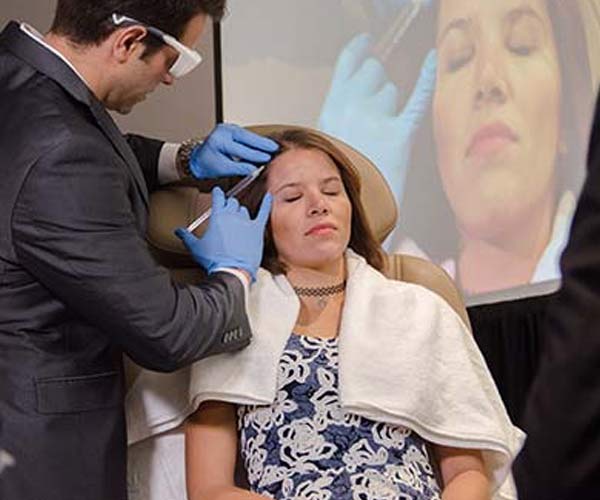What Are Platelet Rich Plasma “Vampire” Facials?
By Dr. Stephen Cosentino
PRESIDENT OF EMPIRE MEDICAL TRAINING
You’ve heard of “traditional” facials, which combine massage, heat treatments, and topical masks and serums to rejuvenate facial skin. Maybe you’ve had one or two in your time.
Unless you follow celebs’ beauty procedure gossip, the term “vampire facial” might be new to you. And while it sounds scary, it’s anything but. A vampire facial, also known as a platelet rich plasma (PRP) facial, is just a facial that uses your body’s own platelets (clotting factors) and blood plasma. The adaptation of PRP for cosmetic purposes, specifically in facial rejuvenation treatments, began gaining popularity in the early 2000s and it took off about 10 years ago after celebrities like Kim Kardashian promoted the procedure.
PRP facials’ rejuvenating effects can go well beyond traditional facials’. That’s why many view PRP facials as minimally invasive alternatives to more invasive or longer-lasting cosmetic therapies, such as permanent facial fillers.
What Are Plasma Facials?
Plasma facials use blood plasma and platelets to rejuvenate facial skin. Before the procedure, a trained provider draws blood from the patient, then concentrates the protein rich plasma using a centrifuge.
During the procedure, the patient may receive other facial treatments, such as microneedling and microdermabrasion. The provider then applies the plasma to the treated skin.
Platelet rich plasma contains growth factors that aid in wound healing and may help restore damaged skin. Though results vary by patient, many see noticeable results after PRP facials, such as a temporary lessening of fine lines and wrinkles, increased collagen and elastin production for improved facial volume, and a reduction in scarring.
What Happens During PRP Treatment? Process & How Long It Takes
A plasma facial is an in-office procedure that typically has four steps:
- Preparing the blood. The provider draws a small volume of blood, usually from your arm. Using special equipment, they concentrate the sample and remove the blood cells, leaving only platelet rich plasma.
- Preparing the treatment area. Many PRP facials involve microneedling or microdermabrasion, which require a topical anesthetic to ensure patient comfort. If so, the provider applies a numbing cream to the face and waits a few minutes for it to work.
- Pre-treatment. Once the numbing cream has taken effect, the provider performs the microneedling or microdermabrasion procedure to prepare the skin to receive the plasma.
- Plasma application. Finally, the provider applies the PRP to the face. They spread the material across the entire pre-treatment area to ensure uniform results.
Benefits of Vampire Facials — Why They’re So Popular
Vampire facials, also known as platelet-rich plasma (PRP) facials, have become increasingly popular in recent years - and not just with celebrities like Kim Kardashian. This is because they offer a range of clear benefits over more invasive cosmetic procedures:
Improved Skin Appearance
- May stimulate increased collagen production, leading to reduced wrinkles and fine lines
- Can temporarily reduce the appearance of acne scars and other skin imperfections
- Encourages the production of healthy new skin cells, which is key to overall skin rejuvenation
- Helps improve skin tone, texture, and radiance
Convenience and Minimal Downtime
- Can be completed during a standard office visit, typically taking no more than 60 minutes
- Requires little to no recovery time - patients can often return to normal activities immediately after treatment
- Any minor side effects like swelling and redness usually subside within a few days
- Does not interfere with a patient's regular skincare routine
Natural, Autologous Approach
- Uses the patient's own blood and natural growth factors, providing a more natural alternative to synthetic fillers or toxins
- Taps into the body's innate healing processes to improve skin health and appearance
- Considered a minimally invasive cosmetic procedure compared to more intensive treatments
The combination of improved skin results, convenience, and the natural autologous approach make vampire facials an appealing option for many patients seeking facial rejuvenation.
Are There Any Risks With Vampire Facials and PRP Injections?
While vampire facials are generally considered safe when performed by an experienced, qualified provider, there are some potential risks and side effects to be aware of:
Redness and Swelling: After the treatment, patients may experience redness, swelling, and mild discomfort in the treated areas. This is a normal reaction as the skin heals from the microneedling process. These side effects typically subside within 2-5 days.
Bruising: Some patients may develop minor bruising around the injection sites, though this is usually minimal.
Infection: There is a small risk of infection if proper hygiene and sterile techniques are not followed during the procedure. Patients should avoid touching the treated skin and follow all post-treatment care instructions to minimize this risk.
Allergic Reaction: Since the PRP is derived from the patient's own blood, allergic reactions are very rare. However, patients with certain blood disorders or who are taking blood thinners may not be suitable candidates.
Sun Sensitivity: The treated skin may be more sensitive to UV exposure for a period of time after the procedure, so patients should avoid direct sun and use a broad-spectrum sunscreen.
It's important to note that the depth of the microneedling and the individual patient's skin condition can influence the severity and duration of these side effects. Patients should discuss any concerns with their provider prior to treatment.
Although the overall risk of side effects is low, PRP facials should be performed only by trained, credentialed aesthetic medicine practitioners.
The best PRP facial providers also have training in related and complementary aesthetic medicine disciplines, including hormone-based anti-aging therapies. Many vampire facial patients seek out these therapies as well, and it’s helpful to work with the same provider for everything.
As this innovative technique continues to gain popularity, it provides a significant cosmetic benefit with minimal downtime, making it an attractive option for skin rejuvenation.


